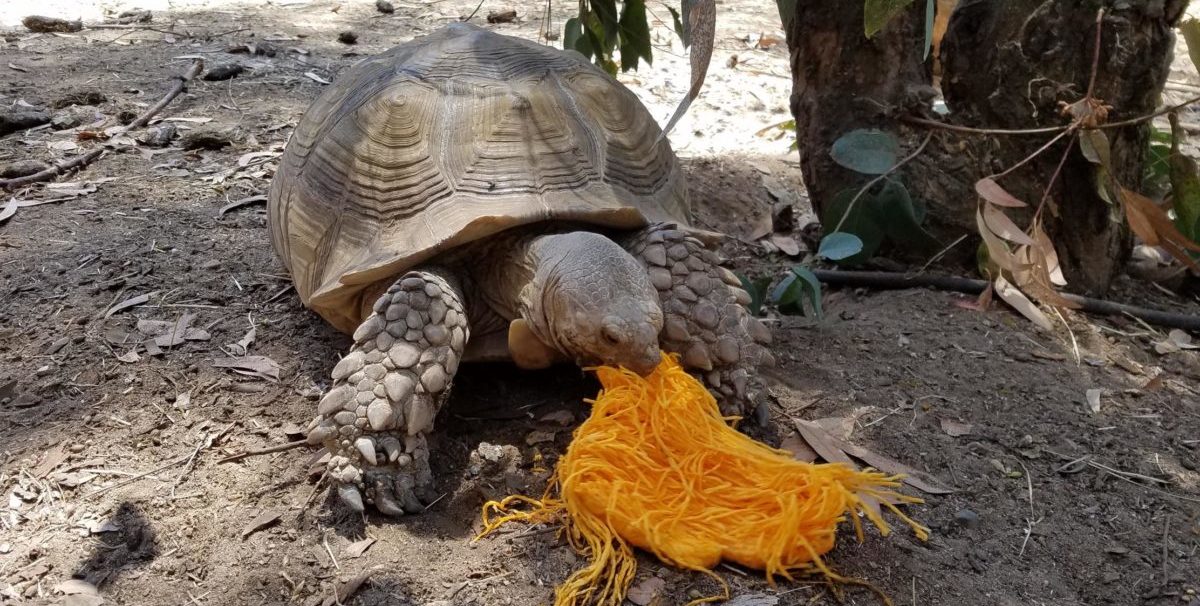Traditionally, little thought was given to enrichment for reptiles, and a pet tortoise can often play a role more like a decorative object than a pet. But times are changing, for good reason.
“In pretty much every species it’s been shown that the ability to have choices and make decisions and perform a full range of natural behavior is paramount to animal welfare,” says Carrie Davis, director of behavior and education at Reptelligence: Reptile Enrichment, Training & Education. “Reptiles are not an alien life form. They’re bound by the same laws of behavior and science of behavior that other species are.”
Research has found that reptiles experience the same range of emotions as other animals.
Tortoises are also much more intelligent than most of us imagine. They’re very trainable, and research has shown that they can remember tasks up to nine years later. The same research suggests they can learn from observing others, something that Debbie McClelland, director of animal care at Maryland Reptile Conservation Center, has seen for herself. A Galapagos tortoise named Gladys she worked with figured how to unlatch and open an inward-opening door to escape her enclosure. “She got out three times before we got smarter and put the latch on the outside,” McClelland says. “It’s hard to be smarter than a tortoise sometimes.”
Just like any other animal, tortoises need enrichment. What’s more, it makes them a more interesting companion.
Will Work for Greens
In the wild, tortoises work for their food. They don’t chase and stalk, but they grab and rip leaves.
“Certain locomotions of their face and head go into that. They might use their legs, they might reach up,” says Davis. “When they pull grass up and bite it from the ground, it’s not the same as eating chopped-up lettuce.”
And though tortoises are stereotyped as slow and inactive, some walk long distances in the wild to get food. “They’re built to move,” she says. “They’re not fast, but they’re built to walk long distances.”
Instead of plopping the same bowl of chopped veggies down in the same place every time you feed, provide a challenge by using food toys made for dogs or hanging food so they have to reach up. Think about the species when considering what behavior you’re trying to encourage. “Grassland tortoises probably do more grazing; those species are probably going to walk further. So, different microclimates and breaking up the line of sight get them moving around more,” says Davis. For types good at climbing, put food at different elevations.
Consider safety with food toys as you would with any pet. Be sure that head, beak, or legs can’t get stuck in openings. If you’re hanging food for them, make sure they can’t get tangled or pinned or fall over.
Along with presenting food in interesting ways, vary the diet. Wild tortoises eat what’s in season. That can mean a lot of one food for a while, and when that’s gone, a lot of another thing. “We can provide a balanced diet not all on one day, but over the course of a week, so they are getting some variation in what they’re seeing and smelling,” says Davis.
Change Is Good
Change and variety stimulate the mind and senses. Don’t just set up a tank and leave it that way forever. McClelland changes something up every time an enclosure is cleaned. “We try to move a plant, add a new plant, change the enclosure a little bit, maybe add something that has a new scent.”
Different species and even different individuals seem to react to different things. “Box turtles are very aware of smells. If I add a stick or a plant that has a new smell to it, I’ll definitely see them checking it out,” she says. “Mud and musk turtles seem more interested in the way things are arranged; they get stimulated by things being moved around, not so much by scent.”
Also, consider age; reptiles go through developmental periods too. For instance, Davis says leopard tortoises need more hides and cover when they are young. “They might not move around if they feel exposed. If you provide more cover, which can be things like plants, partial coverings with hides and ornaments, things that they can move around next to, you might see more movement, because they’re built to hide while they’re small and vulnerable.”
Observe Behavior
Watch your animals react to enrichment. When you know how it’s affecting them, it will give you a new appreciation for them.
“Their signals can be more subtle,” says McClelland. “You need to be aware of and watching for their fear responses. Learn your individual animal and its response, and your species’ response.” Signs like the speed of the throat pulsing, breathing slowing or stopping, and whether they pull back their bodies can all be significant. “This is an animal that communicates, if you learn what to look for,” she says.
Encouraging and observing natural behavior can profoundly change your relationship with your pet. Davis says often our only way of interacting with tortoises is to hold them, which they might not be crazy about. Enrichment lets you share experiences that are positive for both of you.
“You’re seeing them doing things. They become a living thing that has preferences and likes and dislikes and a personality. And that’s what we bond with as humans: those shared experiences with humans and other living things. And that really does change our view of them.”
This article was reviewed/edited by board-certified veterinary behaviorist Dr. Kenneth Martin and/or veterinary technician specialist in behavior Debbie Martin, LVT.








